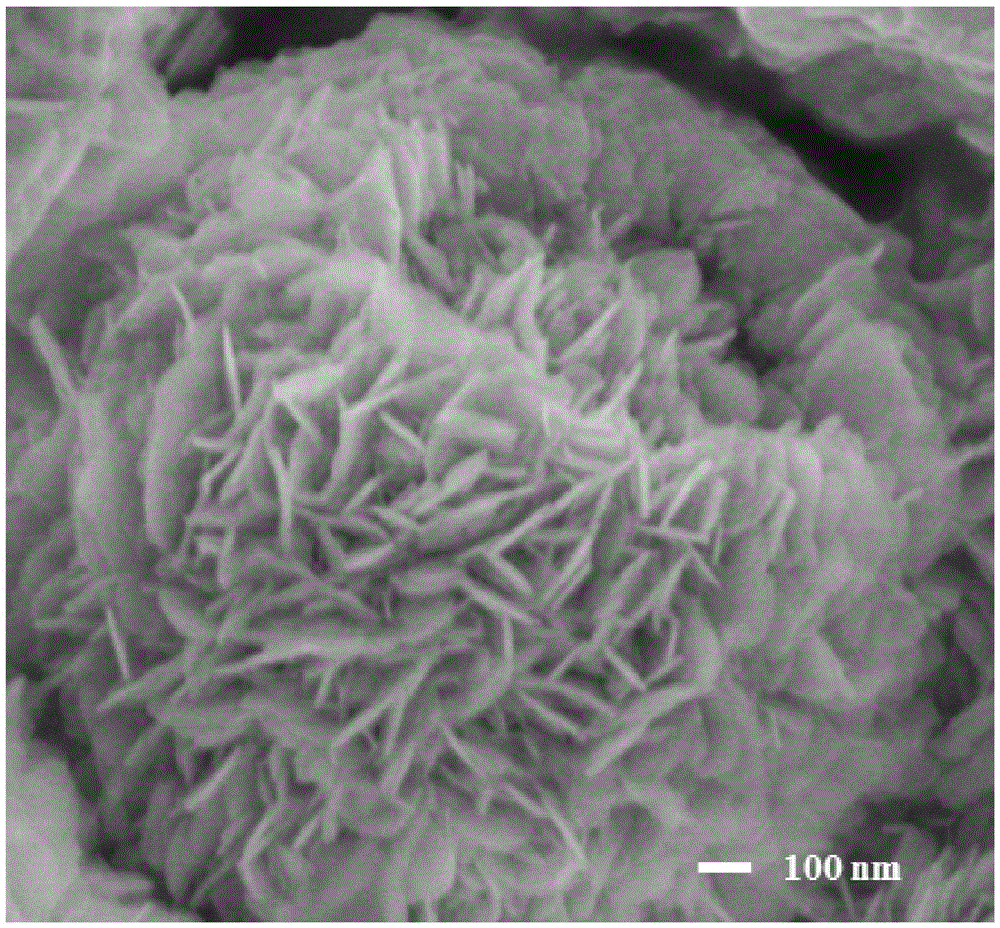Bismuth oxychloride catalyst with visible light response core-shell structure and preparation method thereof
A core-shell structure, bismuth oxychloride technology, used in physical/chemical process catalysts, chemical instruments and methods, oxidized water/sewage treatment, etc., to achieve the effects of good repeatability, high product yield, and easy operation
- Summary
- Abstract
- Description
- Claims
- Application Information
AI Technical Summary
Problems solved by technology
Method used
Image
Examples
Embodiment 1
[0021] The preparation steps of BiOCl visible light catalyst are:
[0022] Step 1: Add 0.01mol of bismuth nitrate pentahydrate to 20ml of ethylene glycol and 5g of polyvinylpyrrolidone (PVP) mixture, and stir at room temperature until bismuth nitrate pentahydrate is completely dissolved;
[0023] Step 2: Use Na(CO 3 ) 2 Adjust the pH value of the above solution to 3, and stir at room temperature for 30 minutes;
[0024] Step 3: Add the product of step 2 into a 100ml hydrothermal reaction kettle, and react at 130°C for 6h;
[0025] Step 4: After step 3 is completed, filter, wash with distilled water and absolute ethanol respectively, and then dry the product at 120° C. for 12 hours.
[0026] The SEM images of BiOCl samples are shown in figure 1 , it can be seen from the figure that the prepared BiOCl microspheres present a core-shell structure and are solid spheres with a diameter of about 1 μm.
Embodiment 2
[0028] The preparation steps of BiOCl visible light catalyst are:
[0029] Step 1: Add 0.01mol of bismuth nitrate pentahydrate to 20ml of ethylene glycol and 5g of polyvinylpyrrolidone (PVP) mixture, and stir at room temperature until bismuth nitrate pentahydrate is completely dissolved;
[0030] Step 2: Use Na(CO 3 ) 2 Adjust the pH value of the above solution to 3, and stir at room temperature for 30 minutes;
[0031] Step 3: Add the product of step 2 into a 100ml hydrothermal reaction kettle, and react at 100°C for 6h;
[0032] Step 4: After step 3 is completed, filter, wash with distilled water and absolute ethanol respectively, and then dry the product at 120° C. for 12 hours.
Embodiment 3
[0034] The preparation steps of BiOCl visible light catalyst are:
[0035] Step 1: Add 0.01mol of bismuth nitrate pentahydrate to 20ml of ethylene glycol and 5g of polyvinylpyrrolidone (PVP) mixture, and stir at room temperature until bismuth nitrate pentahydrate is completely dissolved;
[0036] Step 2: Use Na(CO 3 ) 2 Adjust the pH value of the above solution to 3, and stir at room temperature for 30 minutes;
[0037] Step 3: Add the product of step 2 into a 100ml hydrothermal reactor, and react at 160°C for 6h;
[0038] Step 4: After step 3 is completed, filter, wash with distilled water and absolute ethanol respectively, and then dry the product at 120° C. for 12 hours.
PUM
| Property | Measurement | Unit |
|---|---|---|
| diameter | aaaaa | aaaaa |
| diameter | aaaaa | aaaaa |
| volume | aaaaa | aaaaa |
Abstract
Description
Claims
Application Information
 Login to View More
Login to View More - R&D
- Intellectual Property
- Life Sciences
- Materials
- Tech Scout
- Unparalleled Data Quality
- Higher Quality Content
- 60% Fewer Hallucinations
Browse by: Latest US Patents, China's latest patents, Technical Efficacy Thesaurus, Application Domain, Technology Topic, Popular Technical Reports.
© 2025 PatSnap. All rights reserved.Legal|Privacy policy|Modern Slavery Act Transparency Statement|Sitemap|About US| Contact US: help@patsnap.com

